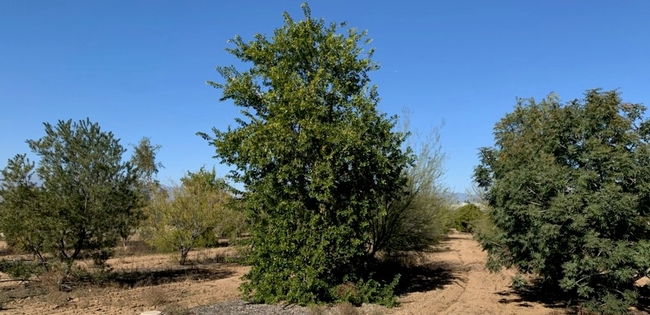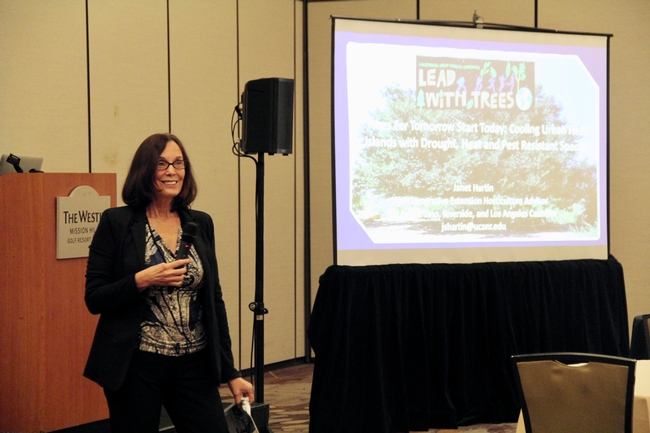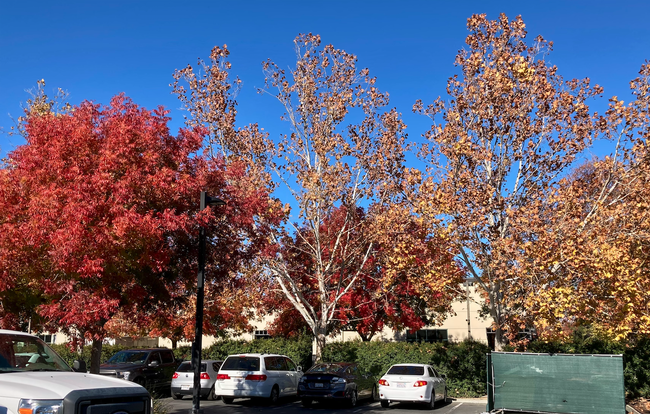Posts Tagged: trees
A Presidential Love of Bees: From 'Bee Houses' to 'Bee Trees'
Today, on Presidents' Day, let's buzz back in history to our first President and his love of honey bees. Picture this: George Washington (Feb. 22,...
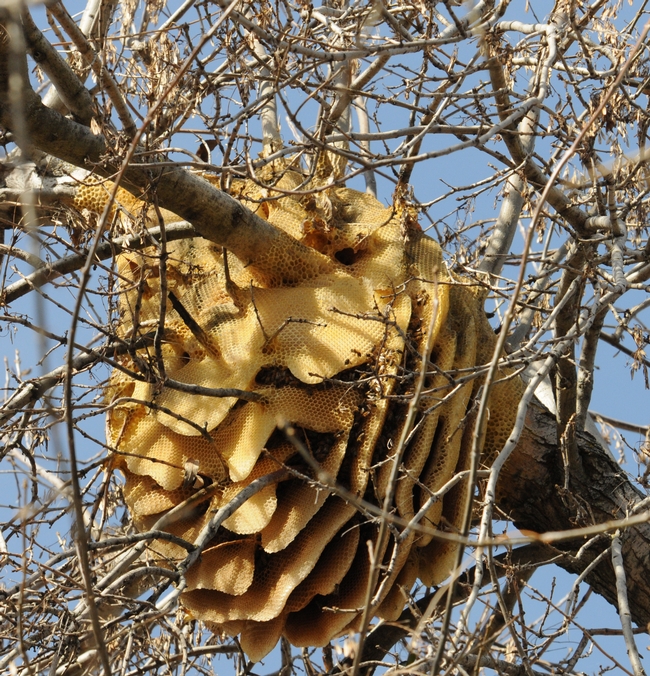
A feral honey bee colony (now gone) in Vacaville, Calif. (Photo by Kathy Keatley Garvey)
Arnon Dag: How to Improve Cross-Pollination in Almond, Pear, Apple and Cherry Trees
How can you improve cross-pollination in such tree crops as almond, pear, apple and cherry? Senior scientist Arnon Dag of the...
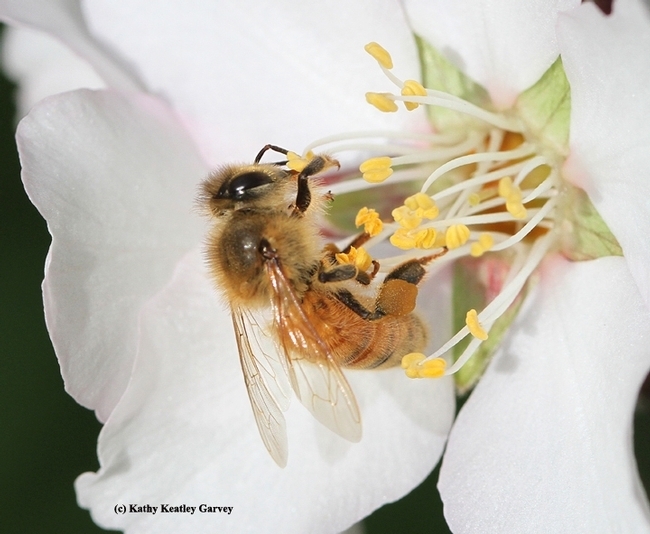
A honey bee pollinating an almond blossom. (Photo by Kathy Keatley Garvey)
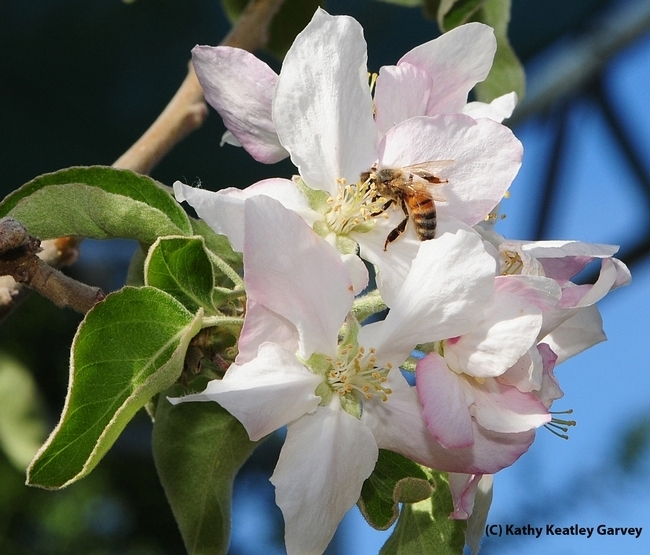
A honey bee pollinating an apple blossom. (Photo by Kathy Keatley Garvey)
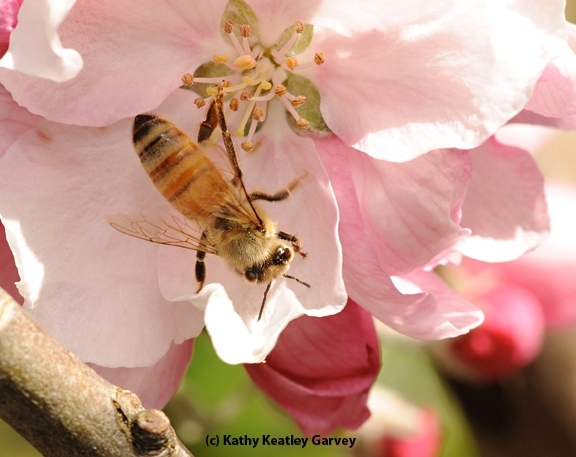
A honey bee pollinating a cherry blossom. (Photo by Kathy Keatley Garvey)
Undergrad Thesis Scores the Cover of Environmental Entomology
It's not every day that an undergraduate thesis makes the cover story of a professional journal. But that's the case with UC Davis doctoral student...
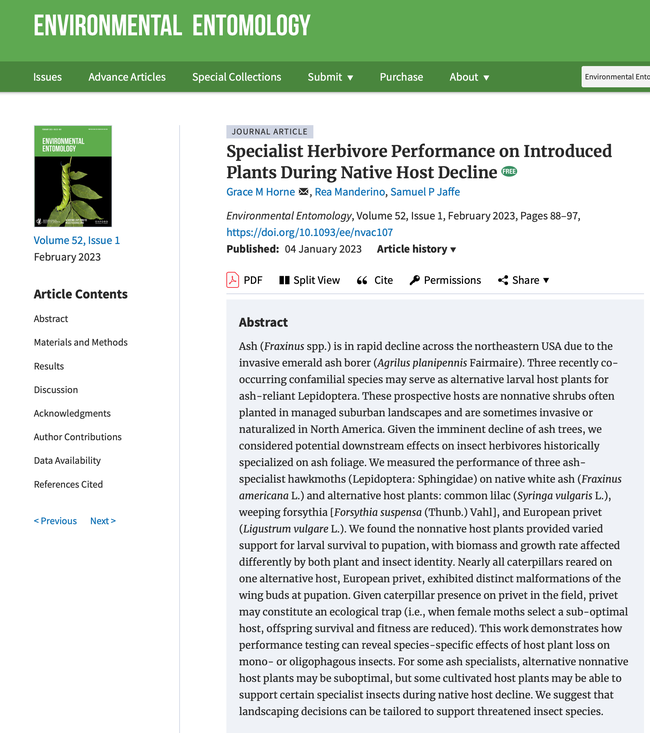
A screen shot of Grace Horne's work that appears in the current edition of the journal Environmental Entomology.
Now is the time to plant climate-ready trees, says UCCE researcher
In a drought-prone region like Southern California, working with Mother Nature is not only wise but necessary, according to Janet Hartin, UC Cooperative Extension horticulture advisor for Los Angeles, San Bernardino and Riverside counties, who studies climate-ready trees.
In 2020, Governor Newsom launched the California Climate Action Corps, empowering Californians to protect their communities from the impacts of climate change. Newsom's call to action emphasizes the need for long-term and sustainable solutions like Hartin's research, which urges Southern California to care for existing trees and plant new ones.
In collaboration with the U.S. Forest Service and other UC Cooperative Extension scientists, Hartin is amid a 20-year research study identifying trees suitable for California's different climate zones. Her work provides a comprehensive understanding of trees and their benefits related to human and environmental health, particularly as Californians navigate climate change's evolving challenges.
One of these concerns is urban heat islands. UHIs are areas in which heat is reradiated from paved concrete or asphalt surfaces. In cities covered in asphalt, like Los Angeles, average temperatures can become six degrees hotter than surrounding areas.
To reduce urban heat islands, she has been working with community organizations to plant trees. In March, for example, Hartin teamed up with the Inland Empire Resource Conservation District to increase tree canopy in the Inland Empire.
“We've collaborated extensively with her over the years, and we knew Janet had been developing a regionally scaled concept for connecting community members to climate-appropriate trees, alongside access to technical assistance from regional UCCE Master Gardeners to ensure long-term tree health and survival,” said IERCD District Manager Mandy Parkes.
Trees keep cities cool
To keep the city cool, some Los Angeles neighborhoods are repainting pavements with reflective coating. According to a 2020 study published in Environmental Research Letters, reflective coating can decrease pavement temperatures up to 10 degrees. As helpful as this is, augmenting urban landscapes to include heat-, drought- and pest-resistant tree species, whether native or not, can significantly reduce the impacts of urban heat islands too.
“Trees can cool impervious surfaces by 40 to 65 degrees,” Hartin said. During a 2021 study, in May and June Hartin discovered that unshaded asphalt could be more than 60 degrees hotter than shaded asphalt during late spring and early summer in inland and desert cities.
Other than providing shade, trees are effective at deflecting the sun's radiation and cooling the atmosphere through evapotranspiration. Given that they absorb and store carbon as well, trees lessen the impacts of pollution from fossil fuels.
“A well-tended mature landscape tree can absorb 40 tons of carbon over its lifespan,” said Hartin.
In a 2021 blog post, Hartin suggests trees be selected based on their adaptation to the “micro-climate” in each particular landscape, noting factors to consider like shade, proximity to buildings, space needs below and above ground, soil type and water source. She also recommends the Sunset Western Climate Zone maps for reference, noting that they are “more precise than USDA zones for our warmer climates.”
Based on the study with the U.S. Forest Service examining the performance of 12 species of underplanted but promising landscape trees at UC Riverside, favorable candidates include bubba desert willow and maverick thornless honey mesquite for their drought resistance, and red push pistache for its drought and heat resistance.
Tamara Hedges, executive director of UC Riverside Palm Desert Center and member of the Board of Directors for the Oswit Land Trust, agrees that trees are important in our fight against climate change:
“Through our partnerships with the UC California Naturalist and the Master Gardener Programs and many other nonprofits in the Coachella Valley, natural ecosystems are being protected and expanded and built environments cooled through the planting of appropriate tree species. These UC/USFS studies go a long way in identifying new underrepresented tree species."
General tips for planting
For California, planting in early fall through late winter provides ample time for trees to establish a strong root system before enduring the summer heat. Doing so also means that natural rainfall can fulfill water needs, as opposed to solely relying on irrigation systems.
Unlike newly planted trees, mature trees should be watered infrequently but deeply. Watering too often can reduce the level of oxygen in the rootzone and result in waterlogged soils prone to crown and root rots.
During the fall, trees only need about 15% of the water they would require in the summer. When watering, keep the tree trunk dry. Because the roots of the tree grow outward and are usually a foot deep into the ground, Hartin recommends watering the area around the trunk rather than the trunk itself. This will also help avoid water waste.
“Trees not adapted to the climate they're planted in and not receiving proper care are much more susceptible to invasive pests like shothole borers and diseases,” said Hartin. “Even the loss of one front yard tree can significantly reduce shade, increase the surrounding temperature, and diminish energy savings.”
Where do fall colors come from?
Did you ever wonder why trees "turn" color in the fall? The short answer: It's primarily a function of long, cool fall nights and short, sunny days.
The longer answer? Chlorophyll is responsible for the basic green color of leaves we see in spring and summer and is a necessary component of photosynthesis, which uses sunlight to manufacture sugar (food) that is stored during the dormant period of the year. Carotenoids produce yellow, orange and even brown pigments in crops such as carrots, squash, bananas and many ornamental plants such as daffodils and poppies. Anthocyanins are red and orange in color and are most linked to lavish displays of brilliant fall foliage. They also give rise to coloring of strawberries, plums and cherries.
Here's the kicker: While chlorophyll and carotenoids are present in leaf cell chloroplasts throughout the entire growing season, most anthocyanins are only produced in fall due to bright light and excess plant sugars within leaf cells.
So, in reality foliage doesn't "turn" orange or red at all. Carotenoids and anthocyanins are always in the leaves; they are simply unmasked once the active growing season is finished and chlorophyll is no longer produced. This happens when nights lengthen in fall.
Interestingly, the actual timing of color change varies across species and appears to be genetically inherited. The same species will exhibit a similar color scheme in cool temperatures in higher elevations at nearly the same time as it does in warmer lower elevation climates. The intensity can vary quite a bit however.
Where do temperatures enter the picture? Both the amount of color and the overall intensity of fall color is very linked to weather conditions that occur prior to and during the actual time the chlorophyll in leaves winds down. The most brilliant displays occur after several warm, sunny days and cool, crisp (above freezing) nights. This is because although lots of sugars are made in leaves during sunny daytime hours, the corresponding cool nights prevent the sugars from moving out. The amount of soil moisture also helps ensure that from year to year fall colors vary even in the same trees. So, either a late spring or a prolonged drought can both delay the display of fall color by a few days or even a few weeks.
What's the recipe for the most brilliant fall display? Most likely a warm, moist spring followed by a warm summer and sunny fall with cool autumn nights.
Although fall color is not nearly as spectacular in lower elevations of Southern California compared to other colder areas of the nation, the liquidambar or American sweet gum (Liquidambar styraciflua) offers some pretty impressive fall color and an impressive 300 to 400-year life span. (Did you know that liquidambar got its name because it at one time was a sought-after chewing gum for Native Americans?)
To help guarantee vivid colors for years to come, growers carefully propagate trees by cuttings to yield identical clones that will produce just as brilliant fall foliage as their parents. You may have come across the popular cultivar named Festival or even have one in your own yard. I like it because it stays more compact and columnar than most liquidambars. The downside? It is less cold tolerant than other liquidambars but does well in most warmer areas of Southern California.
The cultivar Moraine is broader and a better choice if one has adequate space for a shade tree; it is also adapted to cooler temperatures and it rewards homeowners and people passing by alike with beautiful, red fall foliage.


